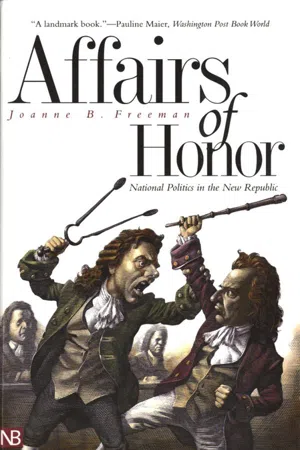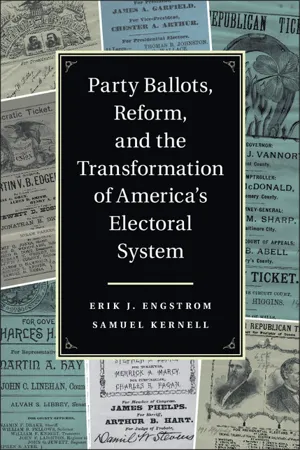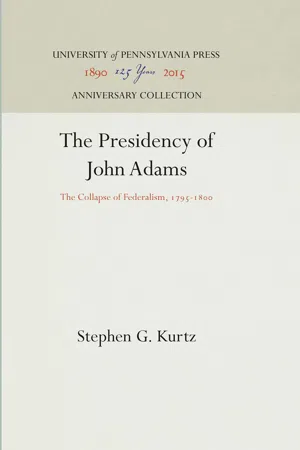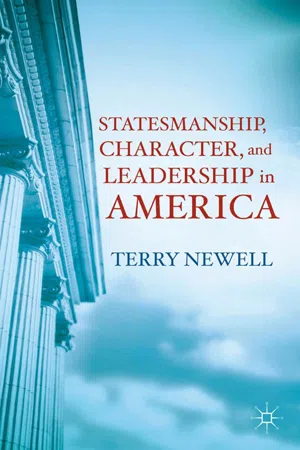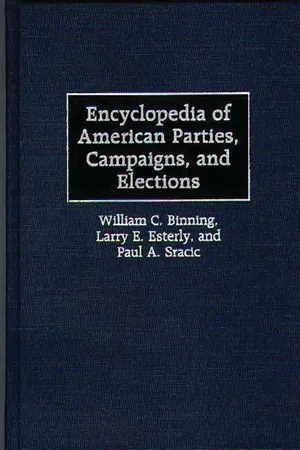History
1800 Presidential Election
The Presidential Election of 1800 was a significant event in American history, marking the first peaceful transfer of power between political parties. It was a highly contentious election between Thomas Jefferson and John Adams, resulting in a tie in the Electoral College. The election was ultimately decided by the House of Representatives, leading to the victory of Thomas Jefferson and the beginning of the Democratic-Republican era in American politics.
Written by Perlego with AI-assistance
Related key terms
1 of 5
6 Key excerpts on "1800 Presidential Election"
- eBook - PDF
Affairs of Honor
National Politics in the New Republic
- Joanne B. Freeman(Author)
- 2008(Publication Date)
- Yale University Press(Publisher)
Each election reshaped the political landscape, revealing a new cast of characters fighting under each ban-ner. The brief hiatus of partisan strife during the first few months after Adams’s election was the product of just such a political reshuffling. Uncertain of new political alliances and enmities, curious to see how the presidential election of 1800 227 Jefferson, Adams, and their political friends would align themselves, the political community waited and watched; even radical Republican newspaper editor Benjamin Franklin Bache declared an official cease-fire in his Philadelphia Aurora . 48 As bodies of principles, Republicanism and Federalism held rea-sonably constant, but individual commitments remained unreliable and unpredictable. Elections forced politicians to declare their loyal-ties; in a murky world of shifting alliances and undeclared intentions, they were bursts of light that revealed in a flash the lay of the political landscape. 49 In 1800, national politicians revisited this disturbingly un-predictable landscape, determined to prevent a recurrence of the prob-lems of four years past. Looking back at the election of 1800 in his later years, Burr would regret that he had not heeded more closely the lessons of 1796. The Election of 1800 For Burr the election of 1796 had been a painful experience—so humil-iating, in fact, that he excluded it from his memoirs. Encouraged by his Virginia friends only to be betrayed at the height of the contest, Burr remembered this emotional lesson when Republicans invited him to run for vice president again in 1800. When John Nicholson asked him whether he cared to run, the normally self-possessed Burr “ap-peared agitated[,] declared he would have nothing to do with the busi-ness[,] that the Southern States had not treated him well on a similar occasion before, that he thought their promise could not be relied on.” He repeated his sentiments to John Taylor of Caroline in a more char-acteristically sardonic strain. - Erik J. Engstrom, Samuel Kernell(Authors)
- 2014(Publication Date)
- Cambridge University Press(Publisher)
2 The Puzzle of Responsive Elections The presidential election of 1880 is most often remembered for its violent aftermath. The assassination of President James Garfield, just six months into his administration, by a jilted job seeker, casts a long historical shadow over the election. But what many political scientists will find more intriguing about 1880 is the election itself. It featured one of the highest voter turnouts – 80 percent of eligible voters – and narrowest presidential vote margins in American history. The 8 million presidential votes broke in favor of Garfield by just more than 2,000, yet they were distributed efficiently, allowing him to eke out a narrow Electoral College majority and keep the White House under Republican control. But perhaps the election’s most remarkable feature is the breadth of the Republican victory in Congress and across the nation. Republicans retook control of the House of Representatives for the first time since 1872. Whether Republicans would wrest control of the Senate from Democrats would not be officially decided until the state legislatures convened the following January. Yet Republicans had ample cause for optimism. Of the twenty-seven non-Southern state legislatures elected that year, Republicans won a majority in both legislative chambers in twenty states and split control in two others. Among these wins were bicameral majorities in six legislatures served by lame-duck Democratic senators. Early the following year the final wave of the Republican victory lapped into Washington with the election of the narrowest possible Senate majority – that is, requiring the Republican vice president’s tie-breaking vote. Considering the Framers had carefully designed the upper chamber to withstand “impetuous” swings of public sentiment by staggering terms and setting up indirect elections, these results are all the more striking. And yet we can see in Table 2.1 that this outcome was unexceptional for the era.- eBook - PDF
The Presidency of John Adams
The Collapse of Federalism, 1795-18
- Stephen G. Kurtz(Author)
- 2017(Publication Date)
4 The Candidates of 1796 HAVING SETTLED THE GREAT FOREIGN POLICY ISSUE OF WASH-ington's second administration, the politicians turned with what must have been a sense of profound relief to the more familiar arguments and devices of electioneering. T h e third presidential contest in the history of the United States, while it was fought out by party organizations that had arisen in response to the administration program, was nevertheless de-cided by what were primarily local or regional issues. T h e President would be chosen only indirectly by the people, and whether Federalists or Republicans would prove vic-torious in state contests for the electoral college often rested on nothing more than the popularity of local politicians. Regional loyalties were stronger than devotion to the new Federal compact, the sense of nationality was yet unde-veloped, and the isolation of most communities such that mo-mentous national issues roused far less interest than the sea-board and urban newspapers of the time imply. Perhaps the most important single factor in the contest (if newspaper sources may be trusted at all) was the personal popularity of the candidates for high office. T h e election of 1796 was vigorously contested, because for the first time opponents of the administration saw a chance to win. Washington was expected to retire from public life, and as the new year opened one of the men most vitally concerned with that eventuality was already contemplating its consequences. 78 The Candidates of ¡796 79 In perfect secrecy between you and me, wrote John Adams to his wife, I must tell you that I now believe the President will retire. The consequence to me is very serious, and I am not able, as yet, to see what my duty will demand of me. Adams concluded that he could only wait, watching the events of the next few moments with close scrutiny, in the hope that Providence would show the way. - T. Newell(Author)
- 2012(Publication Date)
- Palgrave Macmillan(Publisher)
The land mass of the United States itself was nearly double that of France, Spain, and Great Britain combined. 14 The democratic spirit was on the loose. The success of the revo- lution made Americans less deferential to the very gentlemen who had won it. Average men could now aspire to hold office, and many shopkeepers and tradesmen did. Indeed, the generation that crafted a republic was on the verge of handing it over to a generation of the “middling” sort who would turn it into a democracy. In 1800, only 4 of the 16 states had presidential electors chosen by popular vote instead of state legislatures. By 1824, this would be the case in 18 of 24 states. Amid the political, demographic, and social fervent that was “teen- age” America, Jefferson, at nearly six feet, three inches, rose to speak. He carried a text of 1,655 words in 5 paragraphs, written on 4 sides of 2 sheets of paper, each approximately 6-and-a-half by 5-and-a-half inches. 15 A Private Man Crafts a Public Role An intensely private man, Jefferson was comfortable in small groups but retiring in large ones. A capable writer, he drew back from public speaking, lacking a strong voice and oral spontaneity. Indeed, when The Electoral Crisis of 1801 33 he delivered his inaugural address, he could not be heard in the back of the room, a fact also attributable to the Senate chamber itself. 16 But he was more concerned with projecting ideas than utterances. Among these was his view of the presidency. His conception of presidential power, of course, is what worried Federalists. The nominally nonpartisan Washington was their model. The potential for abuse by someone who lacked Washington’s public virtue scared them.- eBook - PDF
The Politics of Ballot Design
How States Shape American Democracy
- Erik J. Engstrom, Jason M. Roberts(Authors)
- 2020(Publication Date)
- Cambridge University Press(Publisher)
4 The Personal Vote Era, 1940–2000 4.1 I N T R O D U C T I O N The political environment in the United States shifted in fundamental ways in the middle decades of the twentieth century. The hyper-partisan competition that had defined the late nineteenth century faded post–1896 and again during the New Deal era as Democrats were dominant in much of the country. With the Jim Crow regime firmly entrenched in the South there was little to no partisan political competition in that region (Aldrich and Griffin 2017). The Democratic dominance in the South helped tame battles for majority control of Congress as Democrats held majority control of the US House in all but two congresses between 1933 and 1995. Additionally, the advent of the direct primary took the power to control nominations for elective office from party elites and placed it in the hands of voters (Merriam and Overacker 1928). The combination of the 17th Amendment, the Australian ballot, and the direct primary cut many of the electoral ties binding parties and candidates together (Carson and Roberts 2013). At the same time, Congress as an institution was evolving in ways that created incentives for members to seek long careers in the insti- tution. After the revolt against Speaker Joseph Cannon in 1909, the decision-making structure of the House became more decentralized as power shifted from the party leadership to congressional committees (Schickler 2001). The seniority system also emerged during this time period (Katz and Sala 1996; MacKenzie 2015). The seniority system helped ensure that members who stayed in Congress for an extended period of time would accumulate power within the respective chambers regardless of their policy views. The concomitant rise of independent 59 60 The Personal Vote Era, 1940–2000 congressional committees and the seniority system served to empower committees generally and their leaders specifically (Polsby 1968). - William C. Binning, Larry E. Esterly, Paul A. Sracic(Authors)
- 1999(Publication Date)
- Greenwood(Publisher)
Page 106 1828 Democratic Party nominee: Andrew Jackson, 56% National Republican Party nominee: John Quincy Adams, 44% This election marked the formal return of twoparty politics to the United States. The Republicans, who had also been known as the DemocraticRepublicans, formally divided into the Democratic and the National Republicans. The alleged corrupt bargain that had placed the incumbent John Quincy Adams into office doomed his chances for reelection. The very notion that Adams could become president while Andrew Jackson had garnered a plurality of the popular votes cast for electors was seen as antidemocratic, and democracy was on the rise in 1828. Only two states (Delaware and South Carolina) did not allow for the popular election of presidential electors. Adams, as he had demonstrated in the election of 1824, was not a candidate who could appeal to the masses. Moreover, the National Republicans, unlike their rivals the Democrats, were not organized at the local level. Jackson’s party understood how to appeal to the general public, an absolute necessity by the late 1820s. The 1828 campaign was probably the longest (and arguably the nastiest) campaign that the United States has ever seen. The campaign began in 1825, when the Tennessee legislature nominated Andrew Jackson for president. There was never any serious doubt that John Quincy Adams would be once again the National Republicans’ choice. In fact, at the National Republican Convention in Pennsylvania (the most prominent of several state conventions) Adams was not even formally nominated. Instead, the Pennsylvania convention selected Richard Rush as the party’s vicepresidential candidate. It was necessary to select a new vicepresidential candidate inasmuch as the incumbent, John C. Calhoun, had joined forces with Jackson. Another National Republican, John Andrew Shulze of Pennsylvania, also received one state’s nomination for vicepresident.
Index pages curate the most relevant extracts from our library of academic textbooks. They’ve been created using an in-house natural language model (NLM), each adding context and meaning to key research topics.
